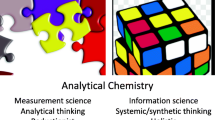Abstract
In this study, we compared the performance as screening tools of two yeast-based recombinant receptor-reporter gene bioassays with a commercial ELISA kit for measurement of total estrogens. For WWTP effluents there was a very good correlation between the measured total estrogen concentrations (ELISA) and estrogenic activity by the hERα bioassay (r2 = 0.93), but not for the medERα bioassay (r2 = 0.50). For freshwater samples, the correlations between bioassay response and ELISA ES measurments were very good (r2 > 0.95). There was no correlation between bioassay response and ELISA ES measurments for estuarine samples.
Similar content being viewed by others
References
Allinson G, Allinson M, Salzman S, Shiraishi F, Myers J, Theodoropoulos T, Hermon K, Wightwick A (2007) Hormones in treated sewage effluent. Final report. A report prepared for the Victorian Water Trust. Department of primary industries, Queenscliff, Australia. Available on-line (last accessed: 4 January 2010): www.ourwater.vic.gov.au/programs/victorian-water-trust/publications
Allinson G, Allinson M, Shiraishi F, Salzman SA, Myers JH, Hermon KM, Theodoropoulos T (2008) Androgenic activity of effluent from forty-five municipal waste water treatment plants in Victoria, Australia. Trans Ecol Environ 110:293–304
Allinson M, Shiraishi F, Salzman SA, Allinson G (2010) In vitro and immunological assessment of the estrogenic activity and concentrations of 17β-estradiol, estrone and ethinyl estradiol in treated effluent from forty-five waste water treatment plants in Victoria, Australia. Arch Environ Contam Toxicol 58:576–586
AOAC (2010) AOAC signs new contract with EPA to develop SMPRs for endocrine disrupting compounds in animal feedlot runoff. Inside Lab Manag 14(3):13–14
Hashimoto S, Ueda Y, Kurihara R, Shiraishi F (2007) Comparison of the estrogenic activities of seawater extracts from Suruga Bay, Japan, based on chemical analysis or bioassay. Environ Toxicol Chem 26:279–286
JEA (1998) Draft manual for surveying exogenous endocrine disrupting chemicals (water, sediment, aquatic organisms). Japan Environment Agency, Water Quality Bureau, Water Quality Management Division, Tokyo, Japan (in Japanese)
Kinnberg K (2003) Evaluation of in vitro assays for determination of estrogenic activity in the environment (No. 43). Danish Environmental Protection Agency, Danish Ministry of the Environment. http://www2.mst.dk/udgiv/publications/2003/87-7972-922-3/pdf/87-7972-923-1.pdf
Morozova VS, Levashova AI, Eremin SA (2005) Determination of pesticides by enzyme immunoassay. J Anal Chem 60:202–217
Nishikawa J-I, Saito K, Goto J, Dakeyama F, Matsuo M, Nishihara T (1999) New screening methods for chemicals with hormonal activities using interaction of nuclear hormone receptor with coactivator. Toxicol App Pharmacol 154:76–83
Shiraishi F, Shiraishi H, Nishikawa J, Nishihara T, Morita M (2000) Development of a simple operational estrogenicity assay system using the yeast two-hybrid system. Kankyo Kagaku 10:57–64 (in Japanese)
Sonnenschein C, Soto AM (1998) An updated review of environmental estrogen and androgen mimics and antagonists. J Steroid Biochem Molec Biol 65:143–150
Streck G (2009) Chemical and biological analysis of estrogenic, progestagenic and androgenic steroids in the environment. Trends Anal Chem 28:635–652
Acknowledgments
The research was primarily supported by the Department of Primary Industries (Project #06889, 08162), with additional assistance from Melbourne Water and the Victorian Water Trust (Project #33 V-4000). The authors confirm that they received no funding from, nor have any financial ties with the manufacturer of the ELISA kit, nor does its use in this study imply any endorsement of the kit by the authors or their respective organisations. The project team gives its thanks to Kathryn Hassell, Kavitha Chinathamby, Trevor Theodoropoulos and Adam Wightwick for assistance with collection of samples, and all the Victorian water authorities, who, in one way or another, contributed to the success of this project.
Author information
Authors and Affiliations
Corresponding author
Rights and permissions
About this article
Cite this article
Allinson, M., Shiraishi, F. & Allinson, G. A Comparison of Recombinant Receptor-Reporter Gene Bioassays and a Total Estrogen Enzyme Linked Immunosorbent Assay for the Rapid Screening of Estrogenic Activity in Natural and Waste Waters. Bull Environ Contam Toxicol 86, 461–464 (2011). https://doi.org/10.1007/s00128-011-0251-x
Received:
Accepted:
Published:
Issue Date:
DOI: https://doi.org/10.1007/s00128-011-0251-x




